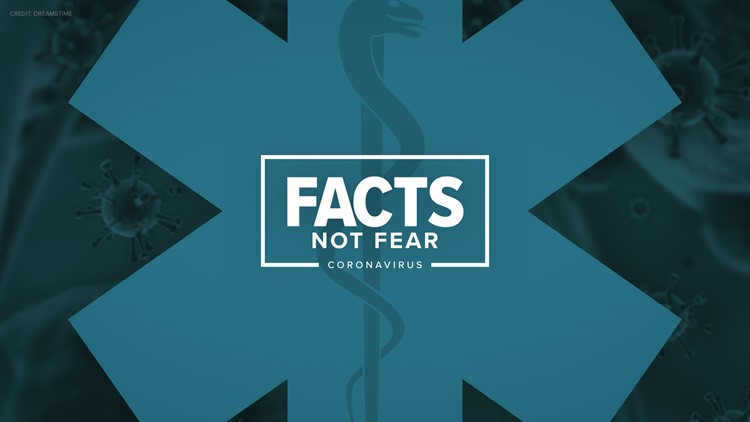COVID-19, a new coronavirus originating from China, has sparked global concern as the outbreak grows.
With all the concerns about coronavirus, there is frankly a lot of information out there, including misleading information.
So we're focusing on the facts, not fear. Here's everything we know about the virus so far, and how you can be prepared.
What is a coronavirus?
According to the World Health Organization, coronaviruses are a large family of viruses that cause illnesses ranging from the common cold to more severe diseases including Severe Acute Respiratory Syndrome (SARS) and Middle East Respiratory Syndrome (MERS).
How did this virus get its name?
On Feb. 11, 2020, the World Health Organization announced the official name for the new coronavirus virus would be COVID-19. "CO" stands for "corona," "VI" stands for "virus," D stands for "disease" and 19 indicates the year the virus was first discovered.
Prior to this, the virus was referred to as the "2019 novel coronavirus," which means it was a new strain not previously identified in humans.
The WHO Director-General also stressed that giving a disease an official name prevents the use of other names that could be inaccurate or stigmatizing.
Where did COVID-19 come from?
The World Health Organization states that coronaviruses are zoonotic, which means they are transmitted from animals to people.
A specific animal source of COVID-19 has not been identified, but the virus has been linked to a large seafood and live animal market in Wuhan, China.
What are the symptoms of COVID-19?
According to the CDC, patients diagnosed with this coronavirus experience a mild to severe respiratory illness. Symptoms include fever, cough and shortness of breath. Patents with severe complications from the virus often develop pneumonia in both lungs.
How does the virus spread?
The virus is spread person-to-person. According to the CDC, spread is happening mainly between people who are in close contact (within 6 feet) of each other via respiratory droplets produced when an infected person coughs or sneezes. The droplets land on the noses and mouths of other people, who then inhale them.
The CDC says it may be possible for the virus to spread by touching a surface or object with the virus and then a person touching their mouth, nose or eyes, but this is not thought to be the main method of spread. As the virus was discovered just a few months ago, more research is required to learn more about the spread pattern of the virus.
How do I protect myself and others?
There is currently no vaccine to prevent COVID-19 or medication to directly treat COVID-19. Therefore, the best way to protect yourself is to avoid being exposed to the virus that causes COVID-19. The CDC recommends maintaining personal preventative actions such as:
- Avoiding close contact with those who are sick
- Not touching your eyes, mouth or nose, especially with unwashed hands
- Washing your hands often with soap and warm water for last least 20 seconds
- Clean and disinfect objects and surfaces that are frequently touched
- Stay home if you are sick
- Cover your coughs and sneezes with a tissue
There also is no need for members of the general public to wear surgical masks to guard against coronavirus. Individuals should only wear a mask if a healthcare professional recommends it.
What should I do if I think I have COVID-19?
Call the office of your healthcare provider if you feel sick with a fever, cough or difficulty breathing. Make sure to give your provider details of your overseas travels and symptoms. Your healthcare provider will give you instructions on how to get help without exposing other people.
Avoid contact with other people, avoid going out in public and delay any travel to avoid spreading the illness.
Is there a cure for the virus?
There is currently no vaccine to protect against COVID-19. Once infected, there is not an antiviral treatment available for COVID-19. People should take care to avoid being exposed to the virus and seek medical care to relieve symptoms if infected with the virus.
How can I prepare for an outbreak?
The risk to the general public remains low but individuals and communities can still prepare for the possibility that an outbreak may occur.
In a press conference on Feb. 25, Dr. Nancy Messonnier, the CDC's director of the National Center for Immunization and Respiratory Diseases said individuals and communities can implement "non-pharmaceutical intervention" methods to reduce the risk of an outbreak.
Individuals should call their local schools and inquire about teleschooling options. Parents should also make a game plan now for child care in the event that a school has to close.
Businesses can prepare by putting in place plans to replace in-person meetings with teleconferences and allowing employees to work remotely when possible. Communities can also modify, postpone or cancel large gatherings, where close contact provides an opportunity for infection.
What is a pandemic? How is a pandemic different from an epidemic or an outbreak?
According to the World Health Organization, a pandemic is the worldwide spread of a new disease.
While an outbreak is the sudden rise in cases of a disease in a particular place, an epidemic refers to a large outbreak that spreads among a region or population. WHO and the CDC have classified the outbreak of COVID-19 in China an epidemic.
While there are cases of COVID-19 in many countries outside of China, WHO has not yet categorized it as a global pandemic. Many countries with COVID-19 infections have reported very few people infected and even fewer, if any, deaths.
This interactive map shows all reported coronavirus cases in the world:
Map is best viewed on desktop. Tap/click for bigger view from Johns Hopkins University



